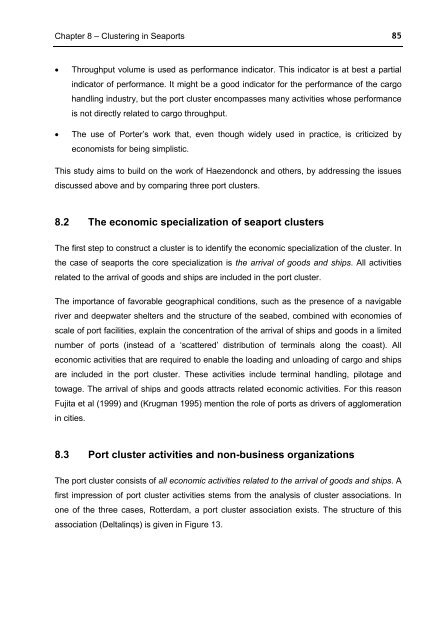The Performance of Seaport Clusters - RePub - Erasmus Universiteit ...
The Performance of Seaport Clusters - RePub - Erasmus Universiteit ...
The Performance of Seaport Clusters - RePub - Erasmus Universiteit ...
Create successful ePaper yourself
Turn your PDF publications into a flip-book with our unique Google optimized e-Paper software.
Chapter 8 – Clustering in <strong>Seaport</strong>s 85<br />
• Throughput volume is used as performance indicator. This indicator is at best a partial<br />
indicator <strong>of</strong> performance. It might be a good indicator for the performance <strong>of</strong> the cargo<br />
handling industry, but the port cluster encompasses many activities whose performance<br />
is not directly related to cargo throughput.<br />
• <strong>The</strong> use <strong>of</strong> Porter’s work that, even though widely used in practice, is criticized by<br />
economists for being simplistic.<br />
This study aims to build on the work <strong>of</strong> Haezendonck and others, by addressing the issues<br />
discussed above and by comparing three port clusters.<br />
8.2 <strong>The</strong> economic specialization <strong>of</strong> seaport clusters<br />
<strong>The</strong> first step to construct a cluster is to identify the economic specialization <strong>of</strong> the cluster. In<br />
the case <strong>of</strong> seaports the core specialization is the arrival <strong>of</strong> goods and ships. All activities<br />
related to the arrival <strong>of</strong> goods and ships are included in the port cluster.<br />
<strong>The</strong> importance <strong>of</strong> favorable geographical conditions, such as the presence <strong>of</strong> a navigable<br />
river and deepwater shelters and the structure <strong>of</strong> the seabed, combined with economies <strong>of</strong><br />
scale <strong>of</strong> port facilities, explain the concentration <strong>of</strong> the arrival <strong>of</strong> ships and goods in a limited<br />
number <strong>of</strong> ports (instead <strong>of</strong> a ‘scattered’ distribution <strong>of</strong> terminals along the coast). All<br />
economic activities that are required to enable the loading and unloading <strong>of</strong> cargo and ships<br />
are included in the port cluster. <strong>The</strong>se activities include terminal handling, pilotage and<br />
towage. <strong>The</strong> arrival <strong>of</strong> ships and goods attracts related economic activities. For this reason<br />
Fujita et al (1999) and (Krugman 1995) mention the role <strong>of</strong> ports as drivers <strong>of</strong> agglomeration<br />
in cities.<br />
8.3 Port cluster activities and non-business organizations<br />
<strong>The</strong> port cluster consists <strong>of</strong> all economic activities related to the arrival <strong>of</strong> goods and ships. A<br />
first impression <strong>of</strong> port cluster activities stems from the analysis <strong>of</strong> cluster associations. In<br />
one <strong>of</strong> the three cases, Rotterdam, a port cluster association exists. <strong>The</strong> structure <strong>of</strong> this<br />
association (Deltalinqs) is given in Figure 13.

















